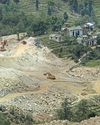Taps will run dry in the South African metropolis of Cape Town in two months. Hundreds of cities across the world are nearing a similar breakdown. Can they avoid a collapse?

THE WATER conservation maxim, “If it’s brown flush it down, if it’s yellow let it mellow,” adorns the walls of hotel rooms in Cape Town, one of South Africa’s richest cities. Its implication becomes clear as one enters Springs Way, the road leading to the city’s most popular natural springs. Here, “ubers” or flatbed trolleys that are used to haul water cans to waiting cars can be seen everywhere. Under the watchful eyes of the local law enforcement authority stationed on the streets, people jostle for space around a three-inch PVC pipe at a spring water collection point in their mad rush to fill bottles, buckets and jerrycans. The precious water flowing out of the numerous pipe holes has become the city’s lifeline as a dry and waterless future stares at the city’s residents. There are already strict restrictions in place to budget water. The municipality has introduced skyrocketing tariffs and penalties if water usage exceeds 6,000 litres per household per month (50 litres per person per day). Last year in September, the limit stood at 87 litres per person per day.
Once an idyllic street located in the upper middle-class suburb of Newlands, Springs Way has turned into a crowded place ever since Cape Town realised it was running dry. “We have been coming here almost every day to supplement the 50 litres of water per person we get from the municipal pipes,” says Louise, a Cape Town resident. Though there is no limit as to how much water one can collect from the spring, a daily limit of 25 litres per person is likely to be imposed when Day Zero hits on July 15, 2018, and the municipal taps run dry. When that sets in, residents will have to queue up to get water ration from collection points under armed guards. Twenty-five litres is a pitiable amount. A toilet flush generally uses about 9 litres of water.
This story is from the March 15, 2018 edition of Down To Earth.
Start your 7-day Magzter GOLD free trial to access thousands of curated premium stories, and 9,000+ magazines and newspapers.
Already a subscriber ? Sign In
This story is from the March 15, 2018 edition of Down To Earth.
Start your 7-day Magzter GOLD free trial to access thousands of curated premium stories, and 9,000+ magazines and newspapers.
Already a subscriber? Sign In

A SPRIG TO CARE FOR
Punarnava, a perennial herb, is easy to grow and has huge health benefits

DIGGING A DISASTER
Soapstone mining near Dabti Vijaypur village has caused many residents to migrate.

REVIEW THE TREATMENT
Several faecal sludge treatment plants in Uttar Pradesh suffer from design flaws that make the treatment process both expensive and inefficient

MAKE STEEL SUSTAINABLE
As India works to double its GDP by 2030, its steel industry must balance growth with sustainability. By embracing policies like the Steel Scrap Recycling Policy 2019 and adopting green technologies, India is paving the way for a more sustainable future in steel production

Can ANRF pull off the impossible for India?
Anusandhan National Research Foundation is expected to reorient India's innovation goals but funding issues, old mindsets remain a drag

TROUBLED WOODS
Forests are a great bulwark against climate change. But this is fast changing. AKSHIT SANGOMLA travels through some of the pristine patches of the Western Ghats to explore how natural disturbances triggered by global warming now threaten the forest health

BLINDING GLOW
The science is clear: increased illumination has damaging consequences for the health of humans, animals and plants. It’s time governments introduced policies to protect the natural darkness and improved the quality of outdoor lighting.

GROUND REALITY
What happens when the soil loses the ability to grow healthy, high-yield crops on its own?

GM POLICY MUST BE FARMER CENTRIC
On July 23, the Supreme Court of India directed the Union government to develop a national policy on genetically modified (GM) crops for research, cultivation, trade and commerce through public consultation.

Vinchurni's Gandhi
A 96-year-old farmer transforms barren land into a thriving forest in drought-prone region of Satara